Boost your Google Ranking in 3 SEO Steps
People often ask me “how do I get to number 1 on Google?”. What they mean is, “how can my website appear as the first result, when someone types a relevant search into Google?”. So if you’re a dog walking business based in Kings Cross, it would be fantastic if your website appeared first when someone searched Google for ‘I need to hire a dog walker in London’. Higher Google ranking = more visitors.
What does SEO mean? You’ve probably heard that SEO will help you get a better Google ranking, but how do you get started? SEO, SEM, PPC, Backlinks… what’s happening?! It can be very confusing to get to grips with the SEO world, so this article will offer 3 easy steps to get started.
Here are 3 quick steps to getting started with SEO. If you don’t have time a lot of time right now, and you just want to know the basics, this is a good place to start. They won’t cover everything you need, but they’re easy to understand. You can implement them yourself, or send this page to a freelancer to implement for you:
1. Increase your Website Speed
2. Create a Google My Business Listing
3. Use Free SEO Tools
Step 1 – Increase your Website Speed
Google has stated that that your website speed is one of the signals used by its algorithm to rank pages. If you are using AdWords to promote your website, your website speed will also be taken into account when determining ad placement. And of course when people visit your website, if they’re waiting a long time, they’ll just leave – probably within 3 seconds. Read more about website speed at Moz. To test your speed, and get suggestions for improving it, use Google’s PageSpeed tool.
Type in your website:

And get your Google PageSpeed score:

View Google’s suggestions for ways to ‘optimise’ your website, and speed it up:

If their suggestions look a bit too technical, don’t worry, I needed help too. Our website is a WordPress website, so I hired a WordPress developer, and he increased our PageSpeed score from 60/100 to 100/100. Actually, that was quite a while ago now, and looking at the above image, we need a little tune-up ourselves! If you could use a little help with this, give me a shout and I’ll introduce you to one of our friendly WordPress experts.
Other simple ways to increase your website speed include using a fast web host, using a Content Delivery Network and optimising the images on your site.
Step 2 – Create a Google Business Listing

You know when you search Google and something pops up on the right with more details about an organisation? For example, if you type in ‘crowdskills’, you get this:

That box on the right is providing information from Google My Business, and it’s one of the best ways to present yourself effectively on Google. It’s also used on Google Maps, so if someone is searching Google Maps for a service you provide, your My Business profile could show up as a result.
For example, when you search for ‘web services’ near Kings Cross:
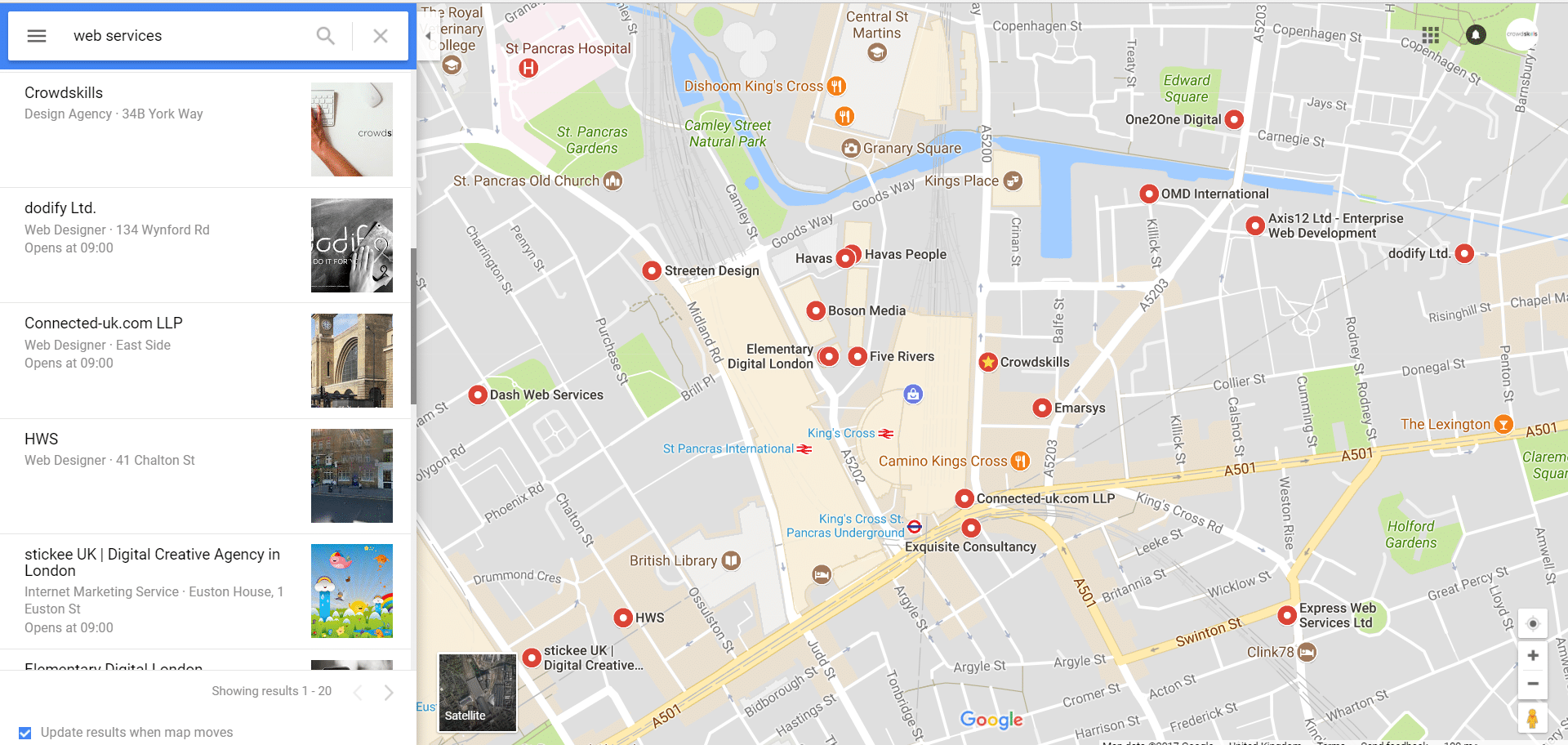
Then if you click on a result, you see the full My Business profile:

My Business is basically Google’s all-in-one tool to manage how your business will look and perform in the search engine. And it’s one of the best way to boost your traffic, especially local traffic. According to the 2017 edition of Moz’ Local Search Ranking Factors Survey, My Business continues to be the biggest driver of local SEO success. Learn more about Google My Business in Yoast’s blog here.
Step 3 – Use Free SEO Tools

Instead of learning everything from scratch, and figuring out how to implement every single SEO technique, why not just use a specialist tool that does it all for you? There are A LOT of these tools out there, but here are 3 that I’d recommend. We’ll start simple with Varvy, move onto more advanced ScreamingFrog, and then finish with my favourite tool, SEMrush.
Varvy is a great place to start. Pop in your website, and it does a full SEO audit. Then it presents its recommendations in a really user-friendly way. It gives you a point-by-point breakdown of your SEO performance, and provides tips on how to learn about the areas you could improve on. Here’s a quick snapshot:
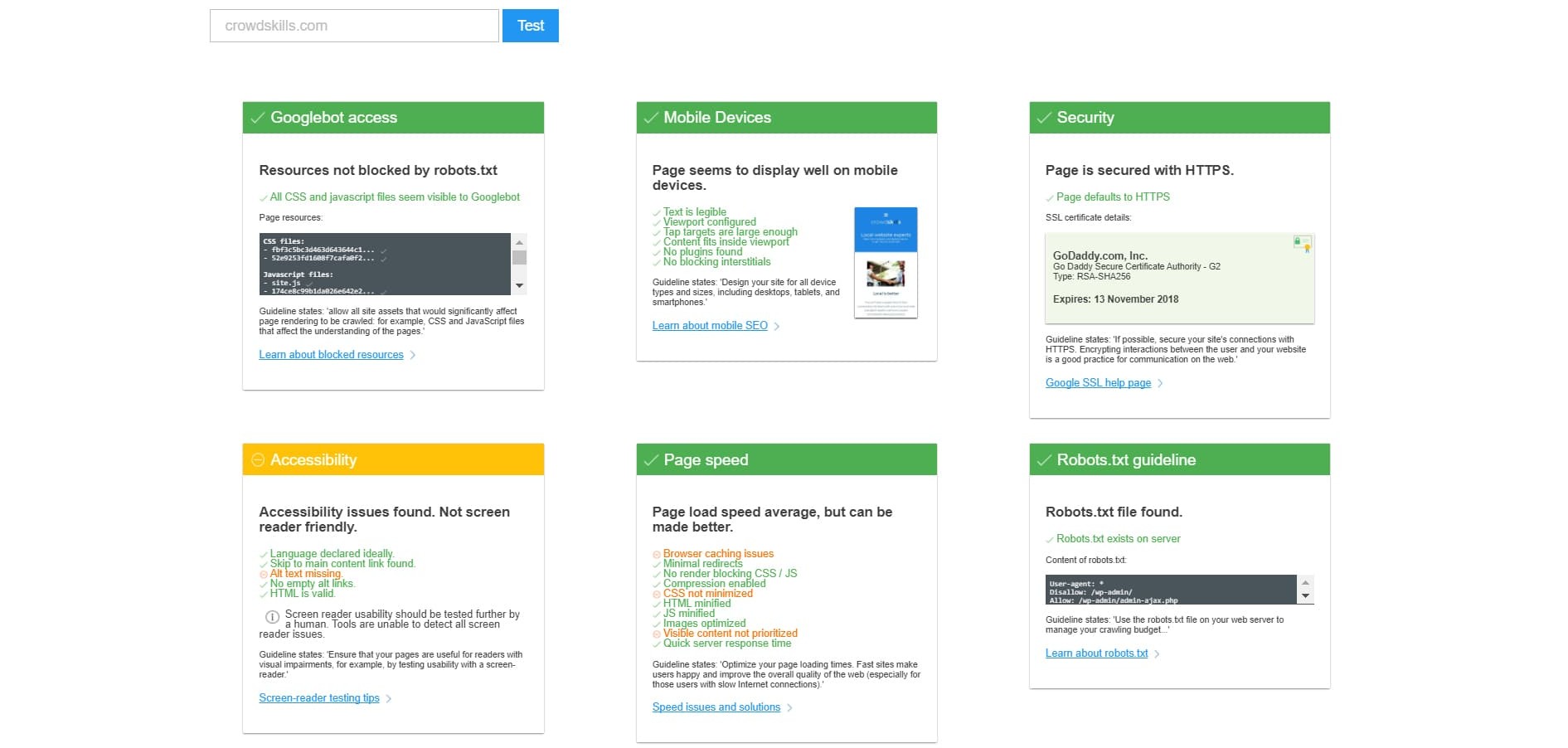
ScreamingFrog is far more advanced. This is an advanced tool that takes a little time to understand, but it has so many features that it’s well worth the time if you have it. As you can see from this snapshot, this tool really does help you access all the data you’ll need. It lets you audit internal and external links, meta descriptions, page titles, keywords, H1, H2, and images amongst other features.
Unlike most other tools that run online, ScreamingFrog is a computer program, so you’ll need to download and install it first. If you want to check it out, I’d recommend starting with their official User Guide, or this quick-start guide. For a super detailed guide of all the features, try this guide. And if you prefer learning by watching, here’s a step-by-step video guide.

My favourite SEO tool is SEMrush.com. Many experts view SEMrush as the industry leader. For me, it offers a great balance between advanced features and simplicity. Let’s take a look and see how it can help your organisation. We’ll use Crowdskills as our example because our website is new and we’re just beginning to work on our own SEO, so this might be a similar use case for you. Ok, let’s go!
Start by typing in your website and choosing your country:

You should immediately see some cool results and graphs:
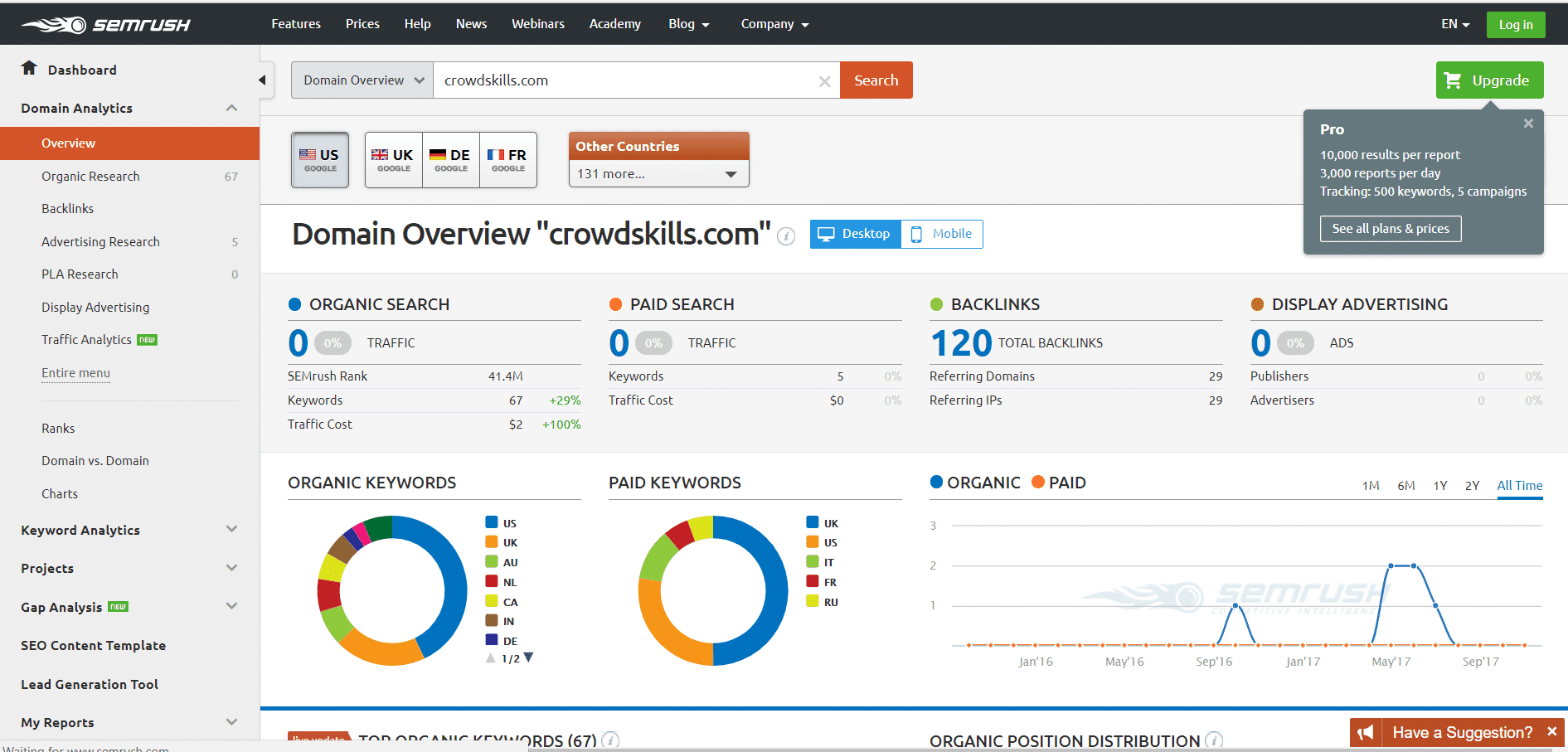
If you get an error saying ‘you’ve reached your limit’, just create an account. It’s free, and comes with some fantastic features. Once you’ve created your account, you should reach your Dashboard, which will give you a quick overview of a few SEO metrics for your website:

There’s lots to look at, particularly on the left hand menu. But for now, I’d recommend starting by creating a ‘Project’ for your website, by clicking on the grey ‘Projects +’ button at the top. Once you’ve created your project, you should see all the available features. Let’s take a look at one of them.

Click on the ‘Set up’ button on the first box – Site Audit. This will check your website for any issues that will prevent Google and other search engines from effectively viewing or ‘crawling’ your website. You may be asked to connect to your Google Analytics, which will give SEMrush access to more useful data. Then you’ll get your score:
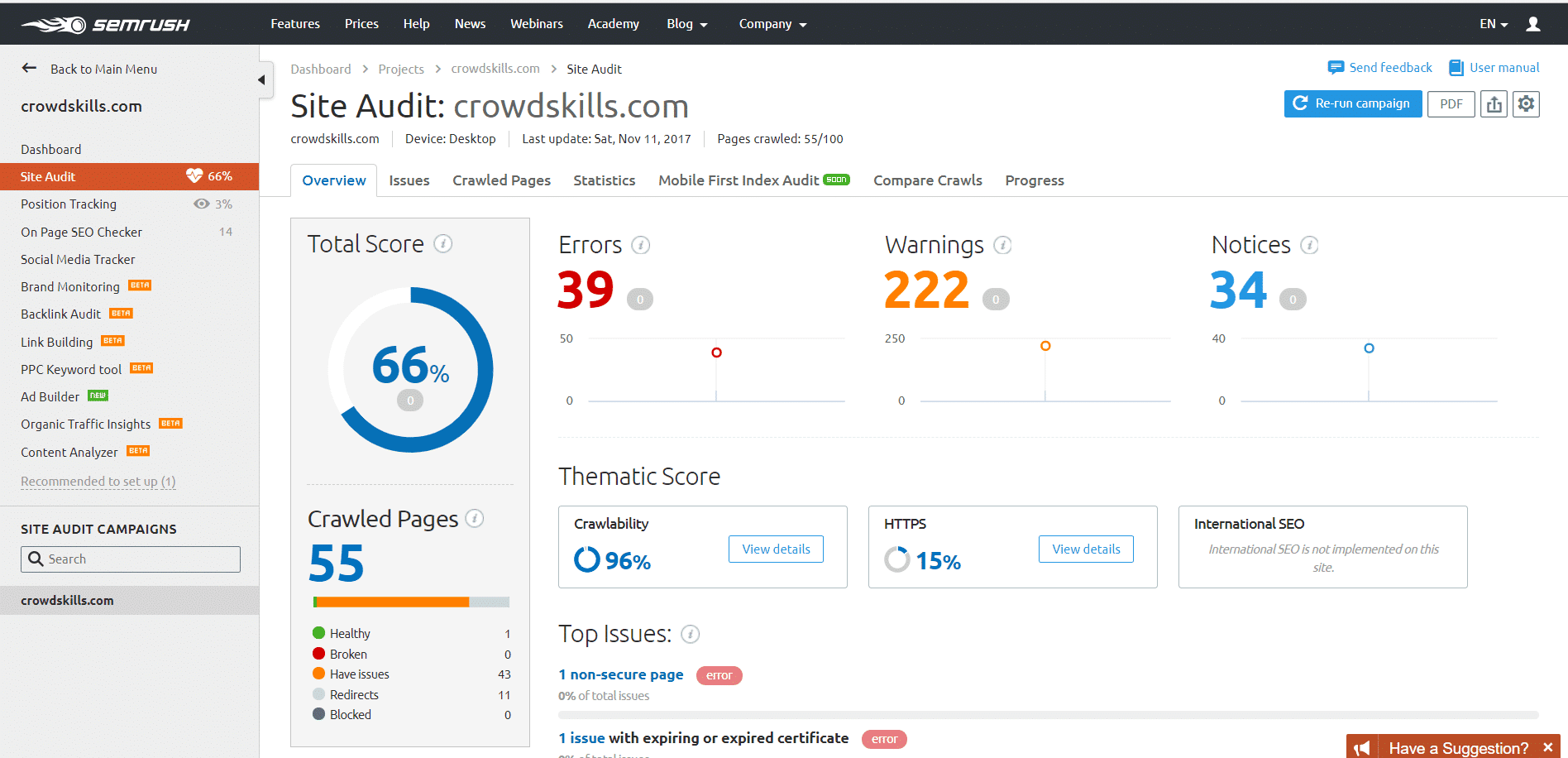
The first thing to look at here is the ‘Issues’ tab, which will detail all the problems with your site. Click on ‘Why and how to fix it’ to get an overview of the issue, and a tip on how to solve it.
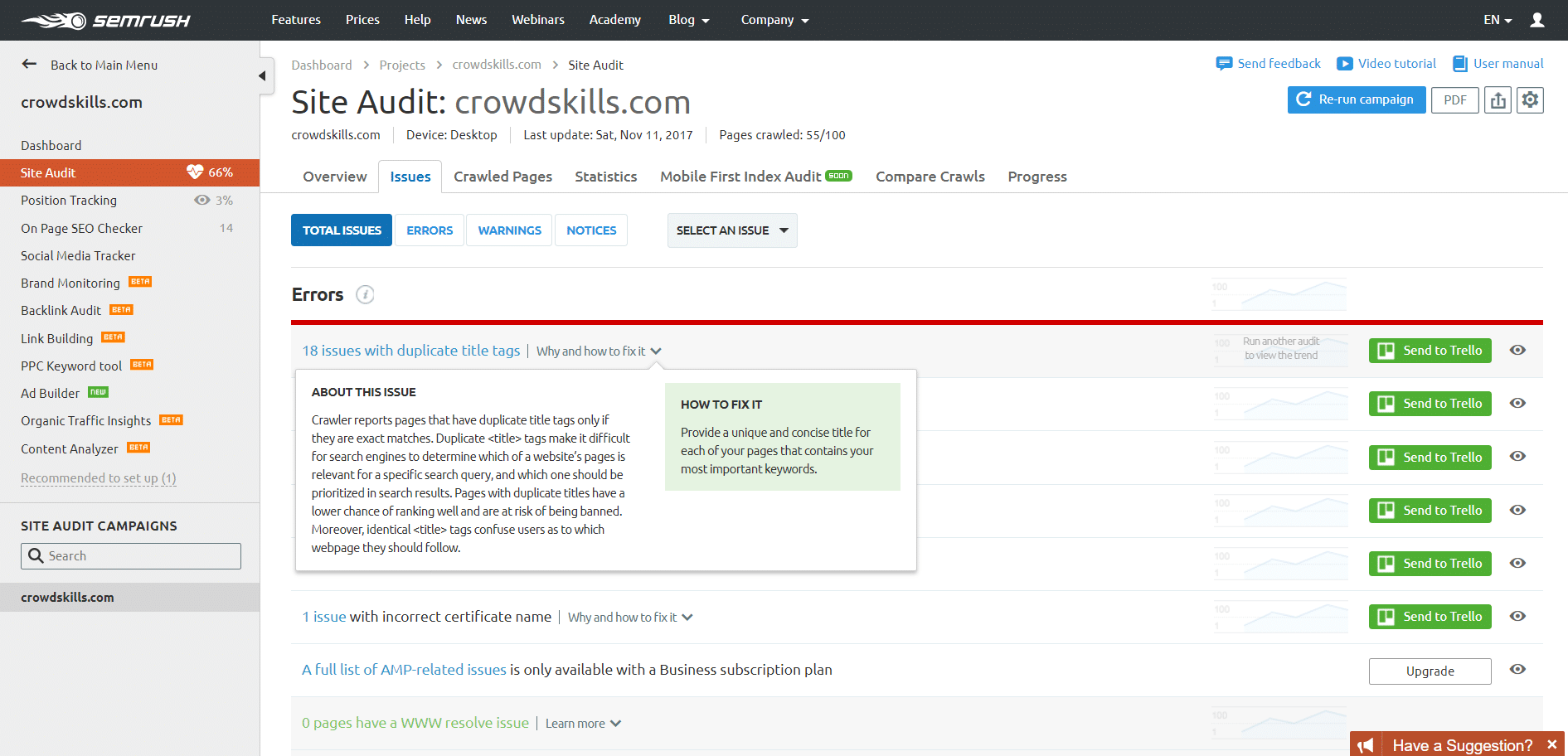
Then click on the name of the issue (in blue font), and it will give a breakdown of all the affected elements within that issue. Use this list to keep track of all the issues, as you fix them on your website. If you’re struggling to actually implement these fixes, get in touch with a freelancer to do it for you.

A few final suggestions for SEMrush. I’d encourage you to start by going all the relevant features in your new ‘Project’ to tighten up your website SEO. Once you’ve done that, go back to the Dashboard and take a look through all the features on the left hand menu. Going through this properly will take quite a bit of time. Use their Getting Started Guide as a baseline, and take up their offer of scheduling an ‘online demo’ with a real person, at the bottom of the left menu.
Final Thoughts on Boosting your SEO
So we’ve looked at three simple steps to boost your SEO and improve your Google ranking. Firstly, increasing your website speed by optimising with Google PageSpeed, finding a faster host and using a CDN. Secondly, creating a listing for your organisation on Google My Business, to present yourself effectively on Google Search results. Finally, using free SEO tools to do the hard work for you, including Varvy, ScreamingFrog and SEMrush.
If you want to move beyond this, and invest some solid time into understanding SEO, I would suggest starting with these great guides: Moz’s Beginners Guide to SEO and Yoast’s SEO Basics. Or, if you’d like to hand over to a professional, get in touch and I’ll introduce you to one of our SEO experts.
Keep up the awesome work – you can do it!
Iman & the Crowdskills team.



